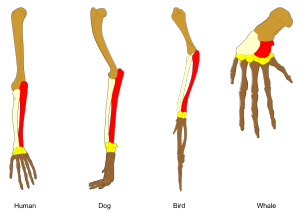**1. Historical Development of Homology:**
– Aristotle observed homology around 350 BC.
– Pierre Belon compared bird and human skeletons in 1555.
– Goethe presented the foliar theory in 1790.
– Etienne Geoffroy Saint-Hilaire described limb homology in 1818.
– Karl Ernst von Baer proposed von Baer’s laws in 1828.
– The term ‘homology’ was coined around 1656.
**2. Understanding Homology in Biology:**
– Homology is similarity due to shared ancestry between structures or genes in different taxa.
– Homologous structures imply divergent evolution.
– Examples include insect wings evolving into different structures.
– Forelimbs of vertebrates show homology in their evolution.
– Analogous organs perform similar functions but evolved separately.
**3. Types and Examples of Homologous Structures:**
– Forelimbs of vertebrates share a common ancestral tetrapod structure.
– Male and female reproductive organs are homologous if they develop from the same embryonic tissue.
– Sequence homology between protein or DNA sequences indicates shared ancestry.
– Homologous structures in different species can show adaptations for specific environments.
– Homology in animal behavior remains controversial but shows suggestive evidence of shared traits.
**4. Applications and Challenges in Homology Studies:**
– Homology aids in reconstructing evolutionary history and phylogenetic relationships.
– Understanding homology helps in predicting gene function across species.
– Distinguishing between homology and analogy can be challenging, especially in complex structures.
– Convergent evolution can lead to structures that are analogous but not homologous.
– The concept of deep homology suggests shared genetic regulatory networks across distantly related species.
**5. Future Directions and Research in Homology Studies:**
– Advances in genomics and bioinformatics have enhanced the study of homology.
– Comparative genomics provides vast datasets for analyzing homologous relationships.
– Evolutionary developmental biology (evo-devo) explores the genetic basis of homologous structures.
– Studying remote homologs using computational tools like DALI expands our understanding of homology.
– Interdisciplinary research combining genetics, morphology, and phylogenetics continues to refine the concept of homology.
In biology, homology is similarity due to shared ancestry between a pair of structures or genes in different taxa. A common example of homologous structures is the forelimbs of vertebrates, where the wings of bats and birds, the arms of primates, the front flippers of whales, and the forelegs of four-legged vertebrates like dogs and crocodiles are all derived from the same ancestral tetrapod structure. Evolutionary biology explains homologous structures adapted to different purposes as the result of descent with modification from a common ancestor. The term was first applied to biology in a non-evolutionary context by the anatomist Richard Owen in 1843. Homology was later explained by Charles Darwin's theory of evolution in 1859, but had been observed before this, from Aristotle onwards, and it was explicitly analysed by Pierre Belon in 1555.

In developmental biology, organs that developed in the embryo in the same manner and from similar origins, such as from matching primordia in successive segments of the same animal, are serially homologous. Examples include the legs of a centipede, the maxillary palp and labial palp of an insect, and the spinous processes of successive vertebrae in a vertebral column. Male and female reproductive organs are homologous if they develop from the same embryonic tissue, as do the ovaries and testicles of mammals including humans. [citation needed]
Sequence homology between protein or DNA sequences is similarly defined in terms of shared ancestry. Two segments of DNA can have shared ancestry because of either a speciation event (orthologs) or a duplication event (paralogs). Homology among proteins or DNA is inferred from their sequence similarity. Significant similarity is strong evidence that two sequences are related by divergent evolution from a common ancestor. Alignments of multiple sequences are used to discover the homologous regions.
Homology remains controversial in animal behaviour, but there is suggestive evidence that, for example, dominance hierarchies are homologous across the primates.
